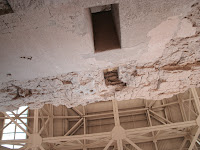 |
| Casa Grande |
If you take Lindsay road and drive
South, through Mesa and Gilbert and through dust and dirt and past
civilization, it will come to a dead end. And you will have to turn.
If you turn one way, it will lead to more dust and dirt and perhaps
unforeseen adventures, but if you turn the other way, you will
eventually find yourself weaving to the other side of the San Tan
mountains and through Indian Reservation to a rare histroic monument
which acts as a portal to another time.
 |
| Another view of Casa Grande |
 |
| These mounds hint and ancient walls |
Casa Grande National Monument is an adobe building built in the 1300s located a few miles outside its namesake town in Coolidge AZ. According to the informational plaques placed around the Monument, the main structure was once part of a flourishing compound. In 1694 Padre Eusebio Francisco Kino visited the site and in his description used "Casa Grade" to describe these ruins and that is how it got its name.
The Sonoran Desert People who lived within or around the structure did not leave behind a written record. They seemed to have abandoned the structure around 1450 AD, as far as we can tell, and the actual purpose of the structure can only be guessed at by the inaudible whispers their artifacts leave behind. Some speculate that it was an ancient observatory and others speculate it was a religious center. Nevertheless, this structure stands silent, protected from the beating desert sun by a roof constructed in 1932.
 |
| It was popular, in the late 1800s and early 1900s, to inscribe your name and even take a piece of the wall for a souvenir. |
Music plays softly as visitors circle
the monument and strive to catch a glimpse of the past within the barred walls of the modest structure. A ceremonial drum is being
played somewhere near us, seemingly close enough to see, which
reminds us that the ghosts of this monument left us a legacy more
than clay and wood, but that their progenetors still inhabit the
Sonoran Desert today.
For some really informative links and more information on the park:
http://www.nps.gov/cagr/index.htm
http://www.nps.gov/cagr/historyculture/the-ancient-sonoran-desert-people.htm
http://www.nps.gov/cagr/parkmgmt/uploa/CAGR%20-%20Centennial%20History%20-%20MAR%2092.pdf
For some really informative links and more information on the park:
http://www.nps.gov/cagr/index.htm
http://www.nps.gov/cagr/historyculture/the-ancient-sonoran-desert-people.htm
http://www.nps.gov/cagr/parkmgmt/uploa/CAGR%20-%20Centennial%20History%20-%20MAR%2092.pdf



No comments:
Post a Comment